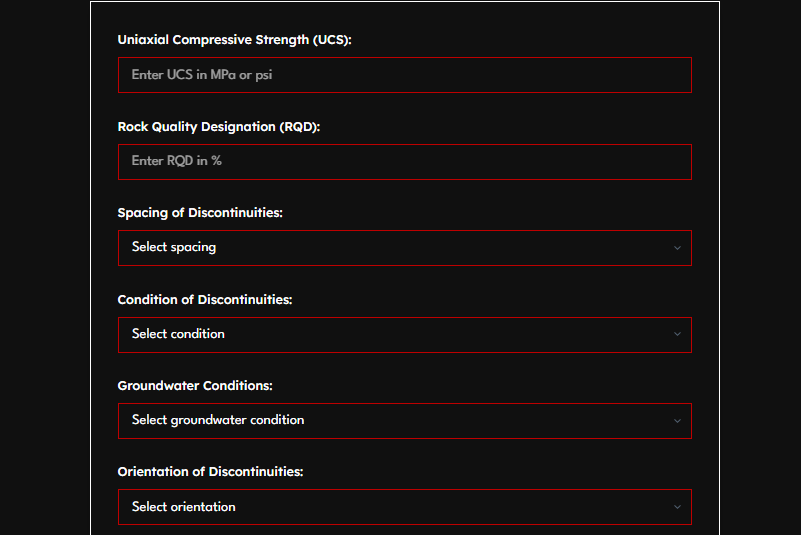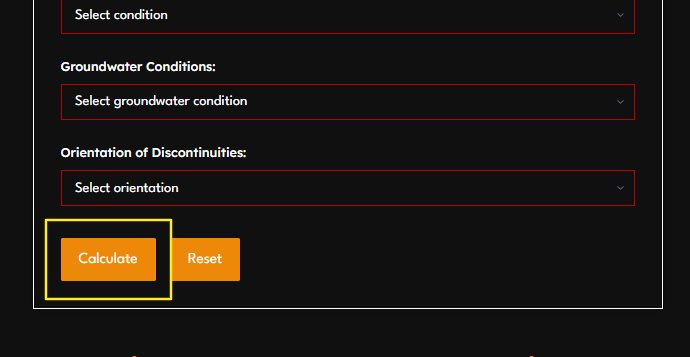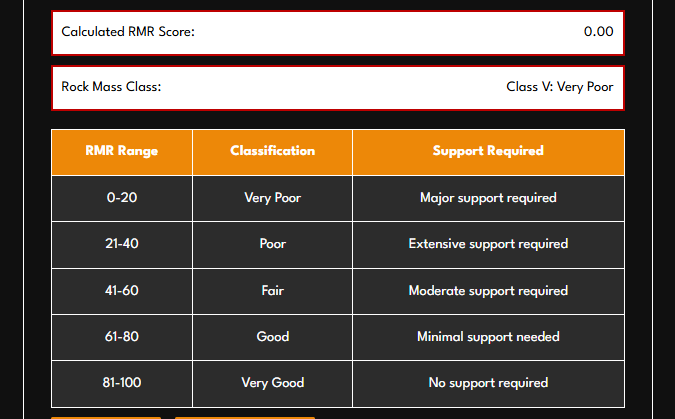Rock Mass Rating Calculator
| RMR Range | Classification | Support Required |
|---|---|---|
| 0-20 | Very Poor | Major support required |
| 21-40 | Poor | Extensive support required |
| 41-60 | Fair | Moderate support required |
| 61-80 | Good | Minimal support needed |
| 81-100 | Very Good | No support required |
Rock Mass Rating Calculator: Step By Step Guide
If you’re involved in rock engineering, mining, or construction, you’ve probably heard of the Rock Mass Rating (RMR) system. It’s a critical tool for assessing the quality of rock masses and determining the support needed for safe and efficient construction. But what exactly is RMR, and how can a Rock Mass Rating Calculator make your job easier?In this blog post, we’ll break down everything you need to know about the RMR system and how to use a Rock Mass Rating Calculator effectively. Whether you’re a seasoned engineer or just starting out, this guide will provide valuable insights to help you make informed decisions.
What is Rock Mass Rating (RMR)?
Bieniawski (1976) introduced the Rock Mass Rating (RMR) system, also known as the Geomechanics Classification, to estimate rock mass strength. Over time, this system has been refined through the examination of additional case records, with significant changes made to the ratings of various parameters. The following discussion is based on the 1989 version of the classification. The RMR system uses six parameters for rock mass classification: Uniaxial Compressive Strength (UCS), Rock Quality Designation (RQD), spacing, condition, and orientation of discontinuities, and groundwater conditions. These factors combine to assign an RMR score between 0 and 100, helping engineers assess rock mass quality and determine support requirements.
How to Use a Rock Mass Rating Calculator
Using a Rock Mass Rating Calculator is straightforward. Here’s a step-by-step guide:
Step 1: Input the Required Data:
- Uniaxial Compressive Strength (UCS): Measure the strength of the rock in MPa or psi.
- Rock Quality Designation (RQD): Provide the percentage of intact rock in the core sample.
- Spacing of Discontinuities: Select the average distance between joints (e.g., close, medium, wide).
- Condition of Discontinuities: Choose the condition of the joints (e.g., very rough, smooth).
- Groundwater Conditions: Indicate the presence of water (e.g., dry, damp, wet).
- Orientation of Discontinuities: Specify the alignment of joints relative to the structure.

Step 2: Click the Calculate button, and the tool will instantly compute the RMR score.

Step 3: Interpret the Results: The calculator will display:
- RMR Score: A value between 0 and 100.
- Rock Mass Class: A classification (e.g., Excellent, Good, Poor) based on the score.
- Support Requirements: Recommendations for the level of support needed.

For example:
- RMR 81-100: Very Good – No support required.
- RMR 61-80: Good – Minimal support needed.
- RMR 41-60: Fair – Moderate support required.
- RMR 21-40: Poor – Extensive support required.
- RMR 0-20: Very Poor – Major support required.
Why Use a Rock Mass Rating Calculator?
Manually calculating RMR can be time-consuming and prone to errors, especially when dealing with complex projects. That’s where a Rock Mass Rating Calculator comes in handy. Here’s why it’s a game-changer:
Saves Time: Automates the calculation process, giving you results in seconds.
Reduces Errors: Minimizes the risk of manual calculation mistakes.
User-Friendly: Designed with simplicity in mind, making it accessible even for beginners.
Provides Insights: Offers a clear interpretation of the RMR score and its implications.
Benefits of Using a Rock Mass Rating Calculator
Improved Safety: Accurately assessing rock quality helps prevent accidents and structural failures.
Cost Efficiency: By determining the right level of support, you can avoid over- or under-engineering.
Better Decision-Making: Provides clear, data-driven insights for project planning.
Accessibility: Even non-experts can use the tool to understand rock mass conditions.
Tips for Accurate RMR Calculations
- Collect Reliable Data: Ensure your input values are accurate and based on thorough field investigations.
- Understand the Parameters: Familiarize yourself with the factors that influence RMR to make informed decisions.
- Use Updated Tools: Choose a modern Rock Mass Rating Calculator with a user-friendly interface and reliable results.
Additional Considerations for Rock Mass Rating
While the RMR system is a powerful tool, it’s important to remember that it’s just one part of a comprehensive geotechnical analysis. Here are some additional factors to consider:
Rock Type: Different types of rock (e.g., granite, limestone, shale) have different properties that can affect their stability.
Weathering: Over time, weathering can weaken rock masses, reducing their RMR score.
Seismic Activity: In areas prone to earthquakes, additional measures may be needed to ensure stability.
Human Activity: Construction, mining, and other activities can alter the stability of rock masses.
By taking these factors into account, you can make more informed decisions and ensure the safety and success of your projects.
Final Thoughts
The Rock Mass Rating Calculator is an invaluable tool for anyone working with rock masses. It simplifies complex calculations, saves time, and provides actionable insights to ensure the safety and success of your projects.Whether you’re planning a tunnel, evaluating a mine, or analyzing slope stability, understanding and using the RMR system effectively can make all the difference. So, why not give a Rock Mass Rating Calculator a try on your next project?
People Also Ask
What is a Rock Mass Rating Calculator?
A Rock Mass Rating Calculator is a tool that evaluates rock quality by analyzing factors like strength, fractures, and groundwater, providing an RMR score for engineering decisions.
Why is RMR important in construction?
RMR helps engineers assess rock stability, determine support requirements, and ensure the safety and efficiency of tunnels, mines, and other structures.
How accurate is a Rock Mass Rating Calculator?
The accuracy depends on the input data. Reliable field measurements and proper parameter selection ensure precise RMR calculations.
Can beginners use a Rock Mass Rating Calculator?
Yes! The calculator is designed to be user-friendly, making it accessible even for those new to rock mechanics and geotechnical engineering.
What does an RMR score of 60 mean?
An RMR score of 60 falls under the “Fair” category, indicating moderate rock quality and the need for moderate support measures in construction.
